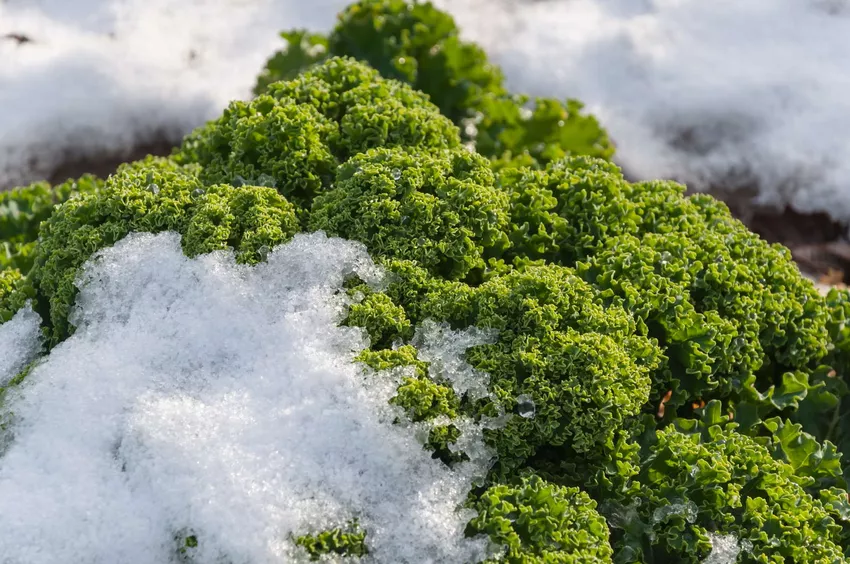Coast on fresh vegetables but no garden? We'll show you how easy it is to grow your own kale on your patio or balcony.

It's the winter vegetable par excellence - on cold days almost nothing tastes as good as a plateful of kale (Brassica oleracea var. sabellica ). But kale can do more than just taste delicious: it is a real vitamin C bomb and is relatively easy to cultivate. But what if you don't have that much space? No problem. Kale can also be grown in a pot without any problems and fits on every balcony or patio, no matter how small. So that your kale will soon sprout too, we will show you what you need to know for successful cultivation in pots.
1. Green cabbage in a pot: choice of variety
There are no differences in kale? Wrong thought. In fact, there are numerous types of kale, some of which differ extremely in their properties. Therefore, you should consider beforehand which variety best suits your needs. Varieties that remain small, such as the lark's tongue, are best suited for growing in pots. But other criteria also play a role: winter hardiness, taste and harvest time are just a few of them. If you like it very unusual, you can also add some color to the bed - varieties such as "Scarlett" or "Redbor" vary between red and violet.

2. Kale in a pot: The right soil
The right soil is essential for kale - especially if it is to be grown in a pot. Since kale is one of the heavy feeders, it is advisable to work the soil with organic fertilizer. This ensures a good supply of nutrients right from the start. The pH value should also be considered when selecting the soil: ideally, this should be between 6.5 and 8. If it is underneath, simply add some lime to the soil to raise the pH. A pre-fertilized organic soil such as our peat-free Plantura organic tomato & vegetable soil is excellent for heavy kale consumerssuitable as it provides him with nutrients right from the start.
3. Kale in a pot: the right location
As a winter vegetable, kale prefers it a little colder. So who is surprised that kale doesn't like the blazing midday sun? A semi-shady spot where the kale is not at the mercy of the midday heat is best suited for growing kale. If the kale gets too warm, it starts to shoot and becomes inedible. Even in the shade, kale usually grows without any problems - it just takes a little longer.

4. Potted kale: Plant kale
Kale is best grown in a large pot about 20cm deep and 30cm in diameter. Only one plant should be grown per pot - since cabbage is a heavy feeder, the plants would otherwise compete with each other for nutrients. Several plants can only thrive in very large pots at the same time, because here, too, each plant should be given 30 cm of space from its nearest neighbor. It is best to start a few seeds indoors from mid-May and transfer the strongest seedlings to the pots later. If that is too time-consuming for you, you can also buy young plants in stores. However, the plants should have found their way into the pot by June at the latest.

5. Kale in a pot: watering and fertilizing
One thing kale doesn't like at all: lack of water. Especially in summer you can watch the green vegetables grow. Accordingly, the kale also needs a lot of water in order to thrive optimally. To make matters worse, the water in the pot evaporates faster than in the open bed. Especially in midsummer, you should therefore regularly check whether the kale needs water. As a rule of thumb, if the first inch of soil is dry, the kale should get some water.

The vigorous leafy vegetable is also very happy about fertiliser: It is best to use primarily organic fertilizers at regular intervals. Our Plantura organic tomato fertilizer is such a primarily organic fertilizer in granular form. The long-term organic fertilizer releases its nutrients to the kale over a period of three months, providing it with everything it needs in the long term.
6. Potted Kale: The Harvest
The harvest time ofKale varies from variety to variety. Some early varieties can be harvested as early as October, but in most cases it is advisable to wait for the first frost. The frost increases the sugar content in the cabbage and makes it milder in taste. You can cut off the leaves of the kale individually with a sharp knife and harvest as needed. Because many kale varieties are extremely hardy, they can be harvested most of the winter.

7. Potted Kale: Store
If you want to enjoy your kale not only in winter but also in summer, you have to preserve it somehow. Most people immediately think of cooking. Although this method has the great advantage that the kale can be kept for a very long time, unfortunately many vitamins and nutrients are lost. The freezer is better suited for storing kale. Chopped up, boiled in s alted water for two to three minutes and then frozen, the kale will keep for at least a year and remain he althy.

It's not just kale that's good for growing in pots: we'll introduce you to the best types of vegetables for pot culture.